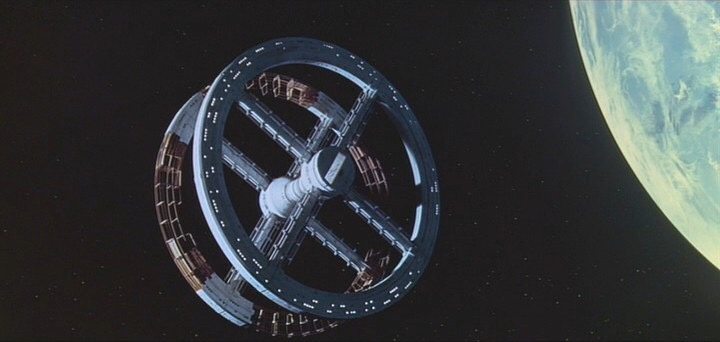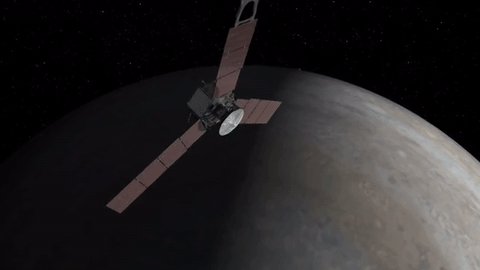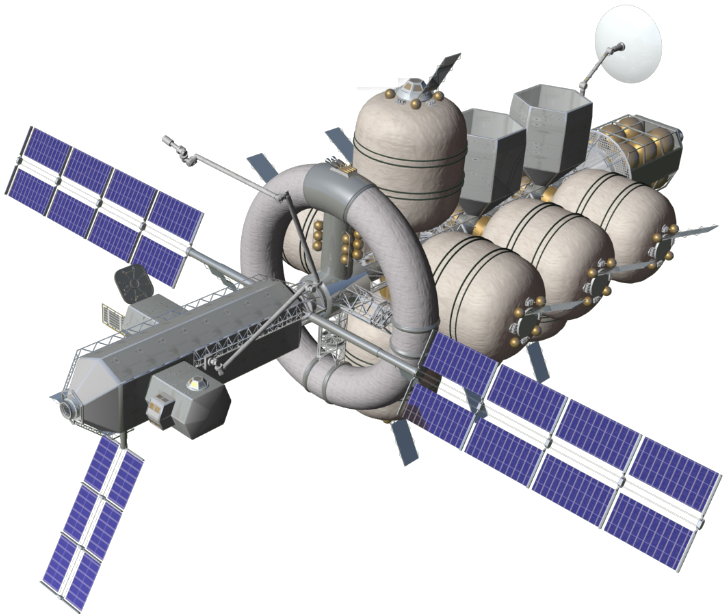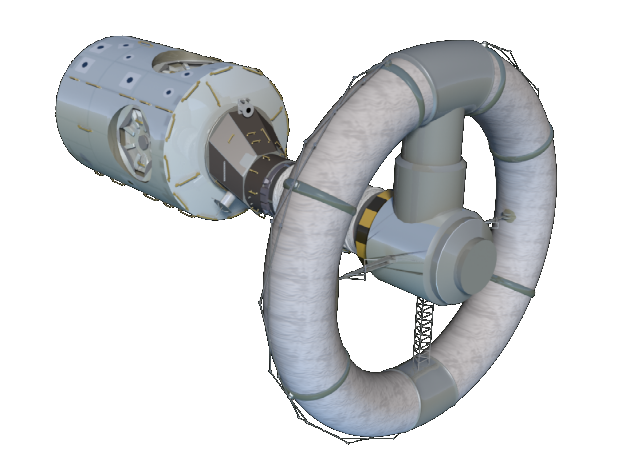Why do spacecraft rotate
For objects in space, rotation is a common thing. When two masses move relative to each other, but not towards or from each other, their gravitational force creates torque . As a result, in the solar system all the planets revolve around the sun.
But this is something that man did not influence. Why do spacecraft rotate? In order to stabilize the situation, constantly send the devices in the right direction and in the future - to create artificial gravity. Let's look at these questions in more detail.

When we look at the car, we know which way it goes. It is controlled by interacting with the external environment - coupling the wheels to the road. Where the wheels turn - there and the whole car. But if we deprive him of this clutch, if we send the car on a bald rubber ride on the ice, it will spin in a waltz, which will be extremely dangerous for the driver. This type of movement occurs rarely on Earth, but in space it is the norm.
')
B.V. Rauschenbakh, an academician and laureate of the Lenin Prize, wrote in “Spacecraft motion control” about three main types of spacecraft motion control tasks:
The rotation of the apparatus is carried out in order to ensure a stable position of the spacecraft. This clearly demonstrates the experiment in the video below. A wheel fixed to the cable will take a position parallel to the floor. But if this wheel is previously unwound, it will retain its vertical position. And this will not interfere with gravity. And even a two-kilogram load, fixed on the second end of the axis, does not change the picture very much.
An example of such a rotation is given by Robert Frost , an instructor and operator at NASA: this is the Juno automatic interplanetary station launched in 2011 for the study of Jupiter and entered the planet's orbit on July 5, 2016 . Rotation is one of the methods of orientation and stabilization , the main advantage of which is efficiency. It is necessary to unwind the device once, and then it will be possible to spin for centuries without using excess fuel and not worrying about controlling the device electronically. If the device’s electronics fails, “Juno” will keep rotating.

It is difficult to notice from the videos, but the International Space Station constantly rotates on the Y-axis at a speed of 4 degrees per minute. This angular velocity is chosen to synchronize the rotation of the station around its axis with its rotation around the Earth. Antennas are watching GPS satellites and communication satellites, and from Earth observation windows it is advisable to see the planet in order to shoot it. Rotation and acceleration are also used to avoid collisions with space debris.
Some spacecraft use rotation for thermal control in order not to overheat one side, which can lead to breakdowns. The International Space Station does not do so, unlike other devices, which are uniformly heated.
In the video below you can see how the station maintains its orientation relative to the Earth.
With interplanetary flights, the moments of forces created by the pressure of sunlight come out to the forefront, and this pressure can help the device to maintain the desired orientation. The spacecraft "Venus" and "Mars" used the following orientation scheme: after the control system gave the device the desired position relative to the Sun, the body was informed about the rotation around its own axis. Then, its movement around the center of mass occurred under the action of two effects: the effect of the top and the moment of force created by the pressure of sunlight. The device acquired properties of a weather vane. Such a complicated scheme made it possible to ensure the constant direction of the solar panels towards the Sun.

Spacecraft "Venus-3"

Concept Nautilus-X .
Adapted to life in the conditions of gravity, the body manages to survive without it. And not only to survive, but also to work actively. But this little miracle is not without consequences. The experience gained over decades of human space flight has shown: man experiences many loads in space that leave a mark on the body and psyche.
On Earth, our body struggles with gravity, which pulls blood down. In space, this struggle continues, but the force of gravity is absent. Therefore, astronauts puffy. Intracranial pressure increases, pressure on the eyes increases. This deforms the optic nerve and affects the shape of the eyeballs. The content of plasma in the blood decreases, and because of the decrease in the amount of blood that needs to be pumped, the muscles of the heart atrophy. The bone mass defect is significant, the bones become brittle.
To overcome these effects, people in orbit are forced to engage in daily physical training. Therefore, the creation of artificial gravity is considered desirable for long-term space travel. Such a technology should create physiologically natural conditions for people living aboard the vehicle. Even Konstantin Tsiolkovsky believed that artificial gravity would help solve many of the medical problems of human space flight.

The idea itself is based on the principle of equivalence of gravitational force and inertial force, which says: “The forces of gravitational interaction are proportional to the gravitational mass of the body, while the inertial forces are proportional to the inertial mass of the body. If the inert and gravitational masses are equal, then it is impossible to distinguish which force acts on a given sufficiently small body - gravitational or inertial force. ”
This technology has disadvantages. In the case of a device with a small radius, different forces will affect the legs and the head - the farther from the center of rotation, the stronger the artificial gravity. The second problem is the Coriolis force , due to the impact of which a person will be rocked to motion with respect to the direction of rotation. To avoid this, the device must be huge. And the third important issue is related to the complexity of the development and assembly of such a device. When creating such a mechanism, it is important to consider how to make possible the constant access of the crew to the compartments with artificial gravity and how to make this torus move smoothly.
In real life, such technology for the construction of spacecraft has not yet been used. For the ISS, an artificial gravity inflatable module was offered to demonstrate the prototype of the Nautilus-X spacecraft. But the module of roads and would create significant vibrations. It would be difficult to carry out the entire ISS with artificial gravity with the current missiles - we would have to assemble everything in orbit in parts, which would at times complicate the scope of operations. Moreover, this artificial gravity would have erased the very essence of the ISS as a flying microgravity laboratory.

The concept of an inflatable module with microgravity for the ISS.
But artificial gravity lives in the imagination of science fiction. The ship "Hermes" from the film "Martian" has a rotating torus in the center, which creates artificial gravity to improve the condition of the crew and reduce the impact of weightlessness on the body.

The US National Aerospace Agency has developed a scale of availability levels of TRL technology from nine levels: from first to sixth - the development of research projects, from the seventh and above - development work and demonstration of technology performance. The technology from the film "Martian" corresponds so far only to the third or fourth level.
There are many uses of this idea in science fiction literature and films. In a series of novels by Arthur Clarke, "Space Odyssey", a Discovery One was described in the form of a dumbbell, the meaning of which is to separate a nuclear reactor with an engine from a residential zone. The equator of the sphere contains a "carousel" with a diameter of 11 meters, rotating at a speed of about five revolutions per minute. This centrifuge creates a gravity level equal to that of the moon, which should prevent physical atrophy under microgravity conditions.

Discovery One from Space Odyssey
In the anime series Planetes, the ISPV-7 space station has huge rooms with familiar earth gravity. The living area and the area for crop production are located in two tori rotating in different directions.

Even solid fiction ignores the enormous cost of such a decision. Enthusiasts took for example the ship "Elysium" from the movie of the same name. Wheel diameter - 16 kilometers. Mass - about a million tons. Sending goods to orbit costs $ 2,700 per kilogram, SpaceX Falcon will reduce this figure to $ 1,650 per kilogram. But it is necessary to carry out 18382 starts to deliver such quantity of materials. This is 1 trillion 650 billion US dollars - almost one hundred annual budgets of NASA.
Until real settlements in space, where people can enjoy the usual 9.8 m / s² acceleration of free fall, still far. Perhaps the reuse of rocket parts and space elevators will bring this epoch closer.
But this is something that man did not influence. Why do spacecraft rotate? In order to stabilize the situation, constantly send the devices in the right direction and in the future - to create artificial gravity. Let's look at these questions in more detail.

Rotation Stabilization
When we look at the car, we know which way it goes. It is controlled by interacting with the external environment - coupling the wheels to the road. Where the wheels turn - there and the whole car. But if we deprive him of this clutch, if we send the car on a bald rubber ride on the ice, it will spin in a waltz, which will be extremely dangerous for the driver. This type of movement occurs rarely on Earth, but in space it is the norm.
')
B.V. Rauschenbakh, an academician and laureate of the Lenin Prize, wrote in “Spacecraft motion control” about three main types of spacecraft motion control tasks:
- Getting the desired trajectory (control of the center of mass movement),
- Orientation control, that is, obtaining the desired position of the spacecraft body relative to external landmarks (controlling the rotational motion around the center of mass);
- The case when these two types of control are implemented simultaneously (for example, when spacecraft approach each other).
The rotation of the apparatus is carried out in order to ensure a stable position of the spacecraft. This clearly demonstrates the experiment in the video below. A wheel fixed to the cable will take a position parallel to the floor. But if this wheel is previously unwound, it will retain its vertical position. And this will not interfere with gravity. And even a two-kilogram load, fixed on the second end of the axis, does not change the picture very much.
An example of such a rotation is given by Robert Frost , an instructor and operator at NASA: this is the Juno automatic interplanetary station launched in 2011 for the study of Jupiter and entered the planet's orbit on July 5, 2016 . Rotation is one of the methods of orientation and stabilization , the main advantage of which is efficiency. It is necessary to unwind the device once, and then it will be possible to spin for centuries without using excess fuel and not worrying about controlling the device electronically. If the device’s electronics fails, “Juno” will keep rotating.

Keeping Directions for Instruments
It is difficult to notice from the videos, but the International Space Station constantly rotates on the Y-axis at a speed of 4 degrees per minute. This angular velocity is chosen to synchronize the rotation of the station around its axis with its rotation around the Earth. Antennas are watching GPS satellites and communication satellites, and from Earth observation windows it is advisable to see the planet in order to shoot it. Rotation and acceleration are also used to avoid collisions with space debris.
Some spacecraft use rotation for thermal control in order not to overheat one side, which can lead to breakdowns. The International Space Station does not do so, unlike other devices, which are uniformly heated.
In the video below you can see how the station maintains its orientation relative to the Earth.
With interplanetary flights, the moments of forces created by the pressure of sunlight come out to the forefront, and this pressure can help the device to maintain the desired orientation. The spacecraft "Venus" and "Mars" used the following orientation scheme: after the control system gave the device the desired position relative to the Sun, the body was informed about the rotation around its own axis. Then, its movement around the center of mass occurred under the action of two effects: the effect of the top and the moment of force created by the pressure of sunlight. The device acquired properties of a weather vane. Such a complicated scheme made it possible to ensure the constant direction of the solar panels towards the Sun.

Spacecraft "Venus-3"
Creating artificial gravity

Concept Nautilus-X .
Adapted to life in the conditions of gravity, the body manages to survive without it. And not only to survive, but also to work actively. But this little miracle is not without consequences. The experience gained over decades of human space flight has shown: man experiences many loads in space that leave a mark on the body and psyche.
On Earth, our body struggles with gravity, which pulls blood down. In space, this struggle continues, but the force of gravity is absent. Therefore, astronauts puffy. Intracranial pressure increases, pressure on the eyes increases. This deforms the optic nerve and affects the shape of the eyeballs. The content of plasma in the blood decreases, and because of the decrease in the amount of blood that needs to be pumped, the muscles of the heart atrophy. The bone mass defect is significant, the bones become brittle.
To overcome these effects, people in orbit are forced to engage in daily physical training. Therefore, the creation of artificial gravity is considered desirable for long-term space travel. Such a technology should create physiologically natural conditions for people living aboard the vehicle. Even Konstantin Tsiolkovsky believed that artificial gravity would help solve many of the medical problems of human space flight.

The idea itself is based on the principle of equivalence of gravitational force and inertial force, which says: “The forces of gravitational interaction are proportional to the gravitational mass of the body, while the inertial forces are proportional to the inertial mass of the body. If the inert and gravitational masses are equal, then it is impossible to distinguish which force acts on a given sufficiently small body - gravitational or inertial force. ”
This technology has disadvantages. In the case of a device with a small radius, different forces will affect the legs and the head - the farther from the center of rotation, the stronger the artificial gravity. The second problem is the Coriolis force , due to the impact of which a person will be rocked to motion with respect to the direction of rotation. To avoid this, the device must be huge. And the third important issue is related to the complexity of the development and assembly of such a device. When creating such a mechanism, it is important to consider how to make possible the constant access of the crew to the compartments with artificial gravity and how to make this torus move smoothly.
In real life, such technology for the construction of spacecraft has not yet been used. For the ISS, an artificial gravity inflatable module was offered to demonstrate the prototype of the Nautilus-X spacecraft. But the module of roads and would create significant vibrations. It would be difficult to carry out the entire ISS with artificial gravity with the current missiles - we would have to assemble everything in orbit in parts, which would at times complicate the scope of operations. Moreover, this artificial gravity would have erased the very essence of the ISS as a flying microgravity laboratory.

The concept of an inflatable module with microgravity for the ISS.
But artificial gravity lives in the imagination of science fiction. The ship "Hermes" from the film "Martian" has a rotating torus in the center, which creates artificial gravity to improve the condition of the crew and reduce the impact of weightlessness on the body.

The US National Aerospace Agency has developed a scale of availability levels of TRL technology from nine levels: from first to sixth - the development of research projects, from the seventh and above - development work and demonstration of technology performance. The technology from the film "Martian" corresponds so far only to the third or fourth level.
There are many uses of this idea in science fiction literature and films. In a series of novels by Arthur Clarke, "Space Odyssey", a Discovery One was described in the form of a dumbbell, the meaning of which is to separate a nuclear reactor with an engine from a residential zone. The equator of the sphere contains a "carousel" with a diameter of 11 meters, rotating at a speed of about five revolutions per minute. This centrifuge creates a gravity level equal to that of the moon, which should prevent physical atrophy under microgravity conditions.

Discovery One from Space Odyssey
In the anime series Planetes, the ISPV-7 space station has huge rooms with familiar earth gravity. The living area and the area for crop production are located in two tori rotating in different directions.

Even solid fiction ignores the enormous cost of such a decision. Enthusiasts took for example the ship "Elysium" from the movie of the same name. Wheel diameter - 16 kilometers. Mass - about a million tons. Sending goods to orbit costs $ 2,700 per kilogram, SpaceX Falcon will reduce this figure to $ 1,650 per kilogram. But it is necessary to carry out 18382 starts to deliver such quantity of materials. This is 1 trillion 650 billion US dollars - almost one hundred annual budgets of NASA.
Until real settlements in space, where people can enjoy the usual 9.8 m / s² acceleration of free fall, still far. Perhaps the reuse of rocket parts and space elevators will bring this epoch closer.
Source: https://habr.com/ru/post/396029/
All Articles